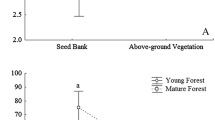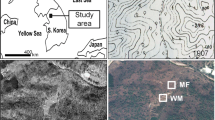Abstract
The prevalence of patchy structures in vegetation is a common feature in semi-arid ecosystems. Although the effect of patches on seed density is widely known, we still lack information on how patch features affect seed bank density and composition. Our aim was to answer two basic questions: (1) How do seed bank density and composition vary within and outside patch aboveground physical limits? and (2) Do patch characteristics affect soil seed bank density and composition? We sampled 50 shrub patches in a semi-arid gypsum system in Central Spain, measuring patch size, composition and structure, and seed bank at three locations per shrub (centre, edge and outside). We calculated the effect of interior patch location, patch composition and structure on seed density and composition. Patches acted both as seed sources, increasing seed density in neighbouring areas and as seed sinks by trapping seeds from bare areas. Patch structure (erect perennial cover) had the greatest effect on seed bank density, whereas patch size and microslope had the greatest influence on bare area density. Patch structure, composition and interior location explained the variation in seed bank composition. Patch effect extends to the surrounding bare matrix creating a seed bank gradient in density and composition. This effect is modulated by patch structure and composition and affects seed bank composition. Our results suggest that the spatial structure of gypsum community seed banks may act as a mechanism for a spatial storage effect contributing to the maintenance of high levels of diversity in semi-arid environments



Similar content being viewed by others
References
Aguiar MR, Sala OE (1994) Competition, facilitation, seed distribution and the origin of patches in a Patagonian steppe. Oikos 70:26–34
Aguiar MR, Sala OE (1997) Seed distribution constrains the dynamics of the Patagonian steppe. Ecology 78:93–100
Aguiar MR, Sala OE (1999) Patch structure, dynamics and implications for the functioning of arid ecosystems. Trends Ecol Evol 14:273–277
Bisigato AJ, Bertiller MB (2004) Seedling recruitment of perennial grasses in degraded areas of the Patagonian Monte. J Range Manage 57:191–196
Borcard D, Legendre P, Drapeau P (1992) Partialling out the spatial component of ecological variation. Ecology 73:1045–1055
Bullock JM, Moy IL (2004) Plants as seed traps, inter-specific interference with dispersal. Acta Oecol 25:35–41
Caballero I, Olano JM, Loidi J, Escudero A (2003) Seed bank structure along a semi-arid gypsum gradient in Central Spain. J Arid Environ 55:287–299
Caballero I, Olano JM, Luzuriaga AL, Escudero A (2005) Spatial coherence between seasonal seed banks in a semi-arid gypsum community, density changes but structure does not. Seed Sci Res 15:153–160
Chambers JC, McMahon JA (1994) A day in the life of a seed—movements and fates of seeds and their implications for natural and managed systems. Annu Rev Ecol Syst 25:263–292
Chesson P (2000a) Mechanisms of maintenance of species diversity. Annu Rev Eco Syst 31:343–366
Chesson P (2000b) General theory of competitive coexistence in spatially varying environments. Theor Popul Biol 58:211–237
Childs S, Goodall DW (1973) Seed reserves of desert soils. US/IBP Desert Biome Research Memorandum, RM, pp 73–75
Cipriotti PA, Aguiar MR (2005) Effects of grazing on patch structure in a semi-arid two-phase vegetation mosaic. J Veg Sci 16:57–66
Escudero A, Carnes L, Pérez-García F (1997) Seed germination of gypsophytes and gypsovags in semiarid central Spain. J Arid Environ 36:487–497
Escudero A, Giménez-Benavides L, Rubio A, Iriondo JM (2004) Patch structure and islands of fertility in a high mountain Mediterranean community. Arc Ant Alpine Res 36:488–497
Flores J, Jurado E 2003 Are nurse-protege interactions more common among plants from arid environments? J Veg Sci 14:911–916
Fowler NL (1986) The role of competition in plant communities in arid and semiarid regions. Annu Rev Ecol Syst 17:89–110
Franco AC, Nobel PS (1988) Interactions between seedlings of Agave deserti and the nurse plant Hilaria rigida. Ecology 69:1731–1740
Guo Q (1998) Microhabitat differentiation in Chihuahuan desert plant communities. Plant Ecol 139:71–80
Gutterman Y (1994) Strategies of seed dispersal and germination in plants inhabiting deserts. Bot Rev 60:373–425
Harper JL (1977) Population biology of plants. Academic Press, London
Holzapfel C, Mahall BE (1999) Bidirectional facilitation and interference between shrubs and annuals in the Mohave desert. Ecology 80:1747–1761
Izco J (1974) Pastizales terofíticos de la provincia de Madrid “Thero-Brachypodion” y “Sedo-Ctenopsion”. Anal Inst Bot Cavanilles 31:209–224
Kemp PR (1989) Seed banks and vegetation processes in deserts. In Leck MA, Parker VT, Simpson RL (eds) Ecology of soil seed banks. Academic Press, San Diego, pp 257–281
Legendre P, Anderson MJ (1999) Distance-based redundancy analysis. Testing multispecies responses in multifactorial ecological experiments. Ecol Monogr 69:1–24
Legendre P, Legendre L (1998) Numerical ecology. Elsevier Science, Amsterdam
Maestre FT, Cortina J (2005) Remnant shrubs in Mediterranean semi-arid steppes, effects of shrub size, abiotic factors and species identity on understorey richness and occurrence. Acta Oecol 27:161–169
Marone L, Cueto VR, Milesi FA, López de Casenave J (2004) Soil seed bank composition over desert microhabitats, patterns and plausible mechanisms. Can J Bot 82:1809–1816
Monturiol F, Alcalá del Olmo L (1990) Mapa de asociaciones de suelos de la Comunidad de Madrid Escala 1,200000. Consejo Superior de Investigaciones Científicas, Madrid
Moro MJ, Pugnaire FI, Haase P, Puigdefábregas J (1997) Mechanisms of interaction between a leguminous shrub and its understorey in a semi-arid environment. Ecography 20:175–184
Olano JM, Caballero I, Loidi J, Escudero A (2005) Prediction of plant cover from seed bank analysis in a semi-arid plant community on gypsum. J Veg Sci 16:215–222
Pugnaire FI, Lázaro R (2000) Seed bank and understorey species composition in a semi-arid environment, the effect of scrub age and rainfall. Ann Bot 86:807–813
Reichman OJ (1984) Spatial and temporal variation of seed distributions in Sonoran desert soils. J Biogeogr 11:1–11
Romao RL (2003) Estructura espacial en las comunidades yesosas, interacciones bióticas y constricciones ambientales. Dissertation, UPM, Madrid
Soriano A, Sala OE, Perelman SB (1994) Patch structure and dynamics in a Patagonian arid steppe. Vegetatio 111:127–135
ter Braak CJF (1986) Canonical correspondence analysis, a new eigenvector technique for multivariate direct gradient analysis. Ecology 67:1167–1179
ter Braak CJF (1988) CANOCO—A FORTRAN program for canonical community ordination by [partial] [detrended] [canonical] correspondence analysis, principal components analysis and redundancy analysis (version 21) Agricultural Mathematics Group, Report LWA-88–02, 14, Wageningen
ter Braak CJF (1990) Update notes CANOCO version 31. Microcomputer Power Itaca, New York
ter Braak CJF, Šmilauer P (1997) Canoco for Windows version 40 Wageningen.Centre for Biometry, The Netherlands
Acknowledgements
We would like to thank Iker Pardo and Garoa Eceiza for assisting with the laboratory work. Greenhouse space was kindly provided by the Plant Physiology Unit of the Basque Country University. Support was provided by a Comunidad de Madrid research project (REMEDINAL S-0505/AMB-0335) and CGL2006-09431/BOS. I. Caballero was funded with a Basque Government predoctoral grant. We would also like to thank J. Margalet and Lori de Hond for carefully editing our English text and anonymous reviewers for their valuable comments.
Author information
Authors and Affiliations
Corresponding author
Appendix
Appendix
Rights and permissions
About this article
Cite this article
Caballero, I., Olano, J.M., Escudero, A. et al. Seed bank spatial structure in semi-arid environments: beyond the patch-bare area dichotomy. Plant Ecol 195, 215–223 (2008). https://doi.org/10.1007/s11258-007-9316-7
Received:
Accepted:
Published:
Issue Date:
DOI: https://doi.org/10.1007/s11258-007-9316-7




